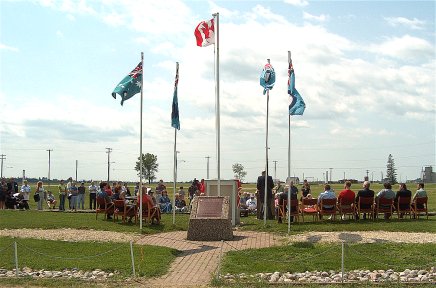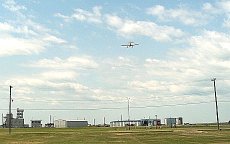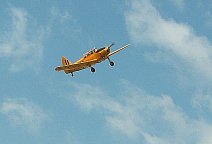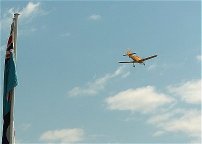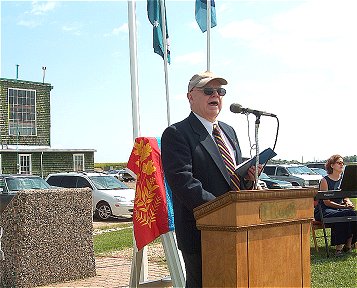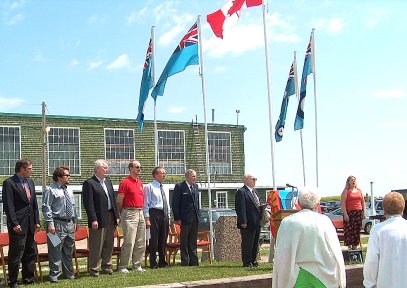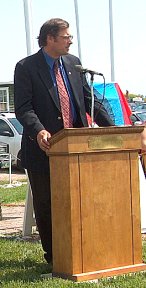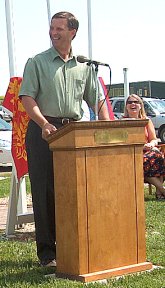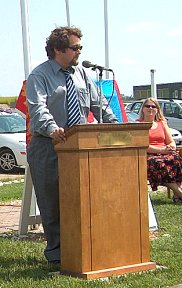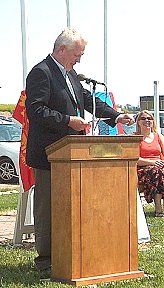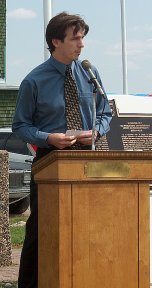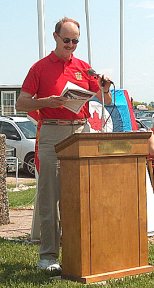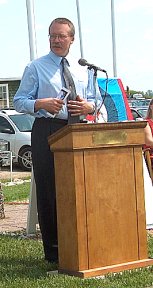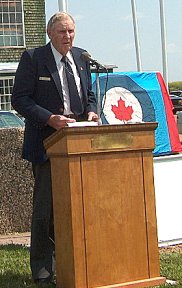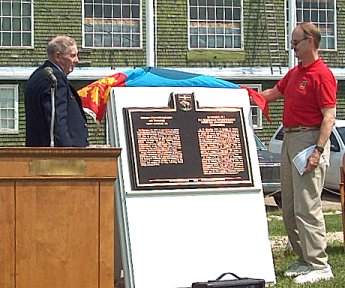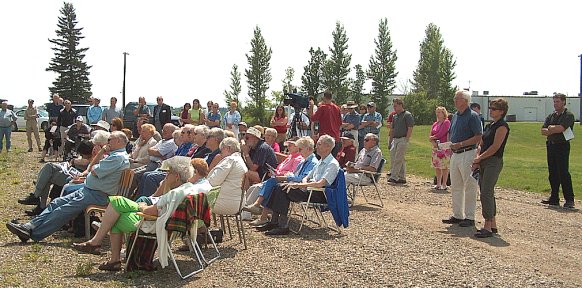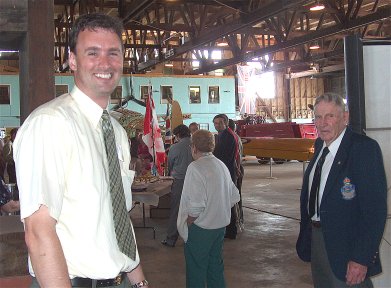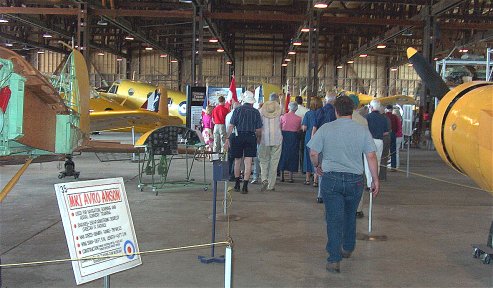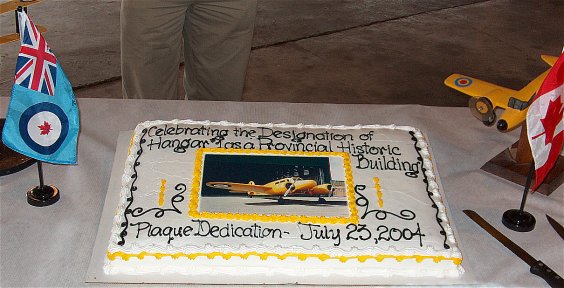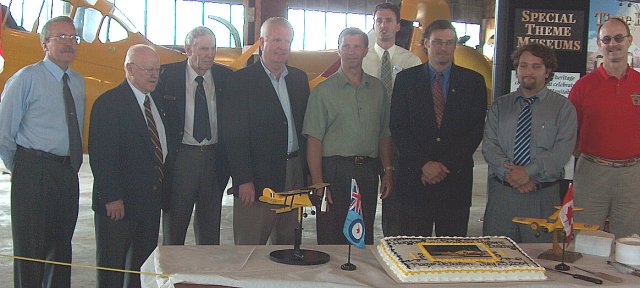Guest
Speaker
Archie
Londry
WWII
Veteran Flying Instructor
#12
Service Flying Training School, Brandon
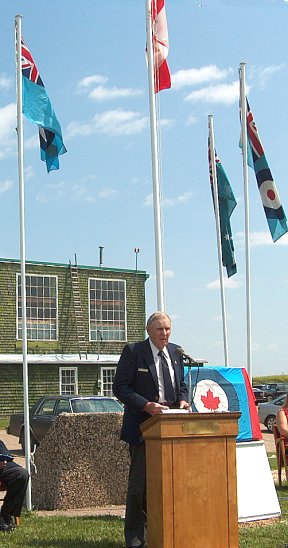 As
the song goes "I've looked at clouds from both sides now" is perhaps why
I have been asked to say a few words about the Commonwealth Air Training
Plan Museum.
As
the song goes "I've looked at clouds from both sides now" is perhaps why
I have been asked to say a few words about the Commonwealth Air Training
Plan Museum.
I trained under the plan and was a flying instructor in
the Plan and for some period of time was here at #12 S.F.T.S. Service Flying
Training School. Just a bit about the Plan. When you enlisted, your first
posting was to Manning Depot, which was basic training, very strict discipline
and tough conditioning.
I don't know what kind of animals they thought we were
but all Manning Depots were in old barns. #1 in C.N.E. buildings in Toronto
in the bullpen, #2 in the old Wheat City Arena, which housed livestock
for the Manitoba Winter Fair, and #3 where I started was in the horse barns
at the Edmonton Exhibition grounds.
Next came a posting to either guard or tarmac duty. l
I was sent to #12 S.F.T.S. as an AC deuce. Aircraftman Second Class, you
couldn't get any lower. Time was spent sweeping hangar floors, pushing
and washing aircraft and any other joe-job imaginable.
Next came I.T.S., Initial Training School, ground school
where we were taught theory of flight, navigation (including astro), meteorology,
aircraft recognition, etc.
We were also introduced to the link trainer, a primitive
flight simulator where many washed out without even having been in an aircraft.
It was here also that your M.C. Alex Matheson, when he
was there, learned to cheat if he didn't know how beforehand. Any doubtful
candidates were measured for leg length to assure they could reach the
rudder pedals of a Tiger Mother.
This consisted of sitting with back to wall and legs extended.
Alex managed to wiggle his little bum (it was then) forward a couple of
inches thus extending his leg length. I think they knew but they let him
go anyway so he carried his wee cushion from then on when he was flying.
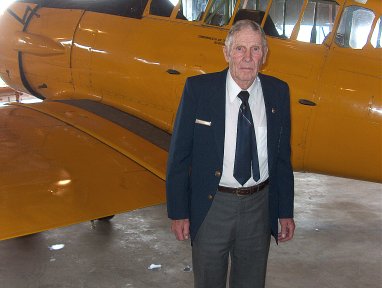 On
graduation from I.T.S. you were promoted to L.A.C., Leading Aircraftsman,
and presented with a white flash to wear in the front of your wedge cape
signifying aircrew. Ground crew and army boys told the girls that it was
a warning that you were infected with V.D.
On
graduation from I.T.S. you were promoted to L.A.C., Leading Aircraftsman,
and presented with a white flash to wear in the front of your wedge cape
signifying aircrew. Ground crew and army boys told the girls that it was
a warning that you were infected with V.D.
From here you went to E.F.T.S., Elementary Flying Training
School, flying Tiger Moths where most of our instructors were old bush
pilots.
Last weekend it was quite a thrill to go to the de Havilland
Aerospace Museum in Toronto and fly the last flight of Tiger Moth 3874
which I had flown 62 years before at #19 E.F.T.S. at Virden, Manitoba.
She is now in retirement.
Next came S.F.T.S., Service Flying Training School, where
those who made it received their wings. From here I was joed into the job
of flying instructor.
After a short stint at F.I.S. Flying Instructor School,
I was again posted to #12 S.F.T.S. as a green kid with a little over 250
flying hours charged with the task of training other kids to fly multi-engine
aircraft then go on as skippers on four engine bombers carrying a crew
of 6 or 7 and dropping bombs on target and returning home again in spite
of weather, flak and enemy fighters.
#12 was a busy place. At peak times we might have 18 or
20 aircraft in the circuit with 3 on final approach and no radios.
Traffic was controlled by aldis lamp and very pistols.
Few accidents occurred on the aerodrome.
However, there were casualties. Besides Canadians, 790
Royal Air Force, 59 Royal Australian Air Force and 41 Royal New Zealand
Air Force airmen were killed in and around Canada. Imagine the grief of
those parents who thought that by being sent away from a war zone their
sons would live at least a few more months.
Of the over 18,000 members of the Royal Canadian Air Force
who lost their lives in all areas, most ranged in age from 19-22. Those
included my roommate here at #12. Their life spans were short.
Some interesting points that happened here:
-
The day water leaked into an underground storage tank and
we had aircraft down all over the area.
-
The day the elevator cable of a Crane was found cut most
of the way through. All aircraft were grounded until inspected. Was it
sabotage?
-
Fire in #1 Hangar. I mentioned use of very pistols. Some
careless pilot had left a loaded one in an aircraft, which happened to
be in the back corner of #1 hangar. A ground crew member doing daily inspections
at night experimented by pulling the trigger and setting the aircraft on
fire. The hangar was full of aircraft and all fuel tanks full of gasoline.
We managed to remove all aircraft and lost only 2, including the original
that burned up on the apron. If you look in the southeast corner of #1
hangar, you can still see signs of charred beams. I had more respect for
the King's dollars than I would have for the Queen's 25 cent ones today.
-
Then there was the mutiny, as far as I know the only one
to occur in the R.C.A.F. in wartime, perhaps because the maximum penalty
for wartime mutiny was death. At the time we had a sadistic S.O.B. of a
Station Sgt. Major whom the boys hated. ONe night they caught him and game
him a severe beating. When he returned from hospital several days later,
they went on strike and refused to obey any orders. As a result he was
posted to another station. There he had a fatal accident a few weeks later.
I would like to acknowledge our ground crew. Those
boys, fitters, riggers, instrument men, etc. with only a few months training
were servicing the aircraft on which our lives depended. There were many
others including W.D.s, Womens Division, who did many jobs. Their motto
was "We serve that men might fly."
Everyone involved had an important job to do but the aircrew
and especially pilots got all the recognition.
I would like to pay tribute to and salute these others.
These are a few of the stories of the Commonwealth Air
Training Plan and #12 Service Flying Training School
We are on historic ground!
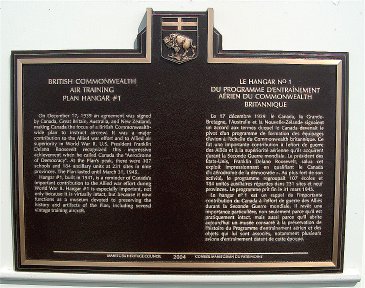
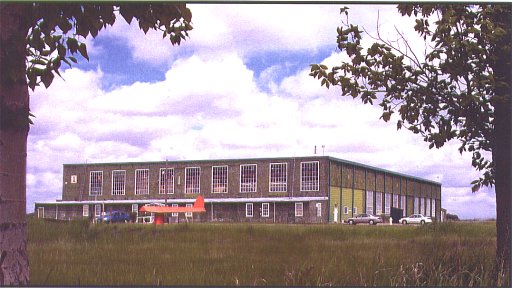
 As
the song goes "I've looked at clouds from both sides now" is perhaps why
I have been asked to say a few words about the Commonwealth Air Training
Plan Museum.
As
the song goes "I've looked at clouds from both sides now" is perhaps why
I have been asked to say a few words about the Commonwealth Air Training
Plan Museum.
 On
graduation from I.T.S. you were promoted to L.A.C., Leading Aircraftsman,
and presented with a white flash to wear in the front of your wedge cape
signifying aircrew. Ground crew and army boys told the girls that it was
a warning that you were infected with V.D.
On
graduation from I.T.S. you were promoted to L.A.C., Leading Aircraftsman,
and presented with a white flash to wear in the front of your wedge cape
signifying aircrew. Ground crew and army boys told the girls that it was
a warning that you were infected with V.D.

